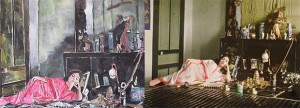 It’s been said that Bob Dylan, like Levi’s, is an American original. Only he might not be as original as he once was, if he was ever as original as people thought. The iconic troubadour isn’t talking, but to look at the evidence, it seems that Dylan has become a copyist of not inconsiderable talent: Several of the 70-year-old’s recent paintings (playing the guitar gets boring, even for rock legends) bear an uncanny resemblance to semi-famous photographs and film stills.
It’s been said that Bob Dylan, like Levi’s, is an American original. Only he might not be as original as he once was, if he was ever as original as people thought. The iconic troubadour isn’t talking, but to look at the evidence, it seems that Dylan has become a copyist of not inconsiderable talent: Several of the 70-year-old’s recent paintings (playing the guitar gets boring, even for rock legends) bear an uncanny resemblance to semi-famous photographs and film stills.
The works in question, from his “Asia Series,” are still very good paintings, in a sort of post-Fauvist/early Picasso sort of way. But Dylan has always maintained that he paints from real life: people he meets on his world tours, street scenes in exotic locales. Even in his golden years, Bob Dylan maintains the image of a scrappy box-car vagabond, traversing land and sea as a student of the human condition. To learn that he has more likely been lounging poolside at his mansion in Los Angeles, aping decades-old photographs, is, well, dispiriting.
But it’ s al so perfectly understandable. He is, after all, 70 years old. What do you want from the guy?
Or maybe he’s just doing what he’s always done: fucking with us.
More upsetting, I think, is the allegation in 2006 that he plagiarized songs from the Civil War-era poet Henry Timrod on his chart-topping album Modern Times. That evidence is pretty hard to ignore: in one song, “When the Deal Goes Down,” Dylan sings, “Where wisdom grows up in strife”; meanwhile, Timrod’s poem “Retirement” reads: “There is a wisdom that grows up in strife.”
Sure, this could be a case of the old “monkeys in a room full of typewriters” theory, that any given set of words will eventually and inevitably be replicated, but it seems a lot more likely that Dylan copied the poetry.
Then again, who care s? Folk singers have always borrowed from other sources; that’s what folk music — and by extension, rock music — is all about. Still, it would probably behoove someone of Dylan’s stature to be up front about it, lest some nosy haters go mining through the Library of Congress in search of any evidence at all that the guy isn’t actually a fountain of eternal creativity, but rather, and merely, a human being.

Comments on this entry are closed.
interesting post, sir. from the Guardian article, it’s unclear that the language about Dylan painting from his life, his travels, comes from him. it’s a gallery spokesperson. i’m not trying to let anyone off the hook – such as it is – but couldn’t this merely be an over zealous PR assistant getting a bit out of their depth?
more substantively, i agree with your final graph. that ppl are shocked that “the times they are a’changin” and any number of other Dylan recordings are repurposings says more about the decline of the cultural commons than anything about Dylan’s “plagiarism.” as i wrote a couple of years ago elsewhere, “Dylan’s freedom to appropriate, reimagine, and make one’s own proved essential to his art, but those rights have been curtailed severely during Dylan’s lifetime. As digital technology has made creative reinterpretation ever more attainable the music industry becomes more strident in its pursuit of infringement claims. To most of us, this seems natural, which is exactly Lewi Hyde’s point (in Common as Air) about the deterioration of the cultural commons.”
David, This is interesting… although I hope you were deploying the term “iconic troubadour” ironically as it relates to the alleged “copyis[m]” you discuss in your article.
It’s not your fault, but I blanch when I read “troubadour”–unfortunately, music writers have microwaved this dime-a-dozen noun beyond the point of it resembling anything but a semi-gelid Hungry-Man.
So, I’m not judging you, and in this case, it actually applies!, but “troubadour” preens its feathers on my pet-peeves list.